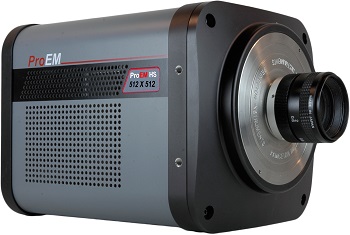Princeton Instruments is pleased to announce the immediate availability of the ProEM®-HS line of high-speed EMCCD cameras with patented eXcelon®3 technology (X3) for low-light imaging and spectroscopy applications.

This advanced back-illuminated EMCCD technology offers combination of high quantum efficiency (>95% QE), best fringe suppression in the near infrared and single-photon sensitivity.
Enabled by its rapid (20 MHz) ADC readout capability and 300 nsec/row vertical shift speed, the new ProEM-HS:512BX3 model delivers > 60 full frames per second. Furthermore, this next-generation camera provides >1,000 fps in imaging mode and >10,000 fps utilizing special high-speed, custom readout modes. Operation is made simple by Princeton Instruments’ powerful, intuitive and user friendly LightField® software.
Thanks to all-metal, hermetic vacuum seal technology that comes with the industry’s only lifetime vacuum guarantee, these ProEM-HS cameras are thermoelectrically cooled to below -90°C using air and liquid for worry-free operation. Other advanced features include a built-in light source for precise electron multiplication (EM) gain calibration, as well as excellent baseline stability, hardware time-stamping, and a Gigabit Ethernet data interface.
“When we set out to design our next-generation ProEM cameras, we knew it would be a tall order,” reflects Ravi Guntupalli, vice president of sales and marketing at Princeton Instruments. “Yet our engineering team not only managed to make these cameras two times faster but also improved their noise performance — even at lower speeds. This is one of the best EMCCD camera offerings on the market for low-light imaging and spectroscopy applications such as single-molecule fluorescence [SMF], astronomy, Bose-Einstein condensates [BECs], and plasma studies.”
New ProEM-HS cameras are fully compatible with Princeton Instruments’ LightField 64-bit application software, which provides complete control of camera features via a cutting-edge graphical user interface. For researchers requiring a custom interface, toolkits for National Instruments’ LabVIEW® and MathWorks’ MATLAB® are available, as are free software development kits (SDKs). The new high-speed EMCCD cameras have also been designed for easy integration with award-winning Princeton Instruments IsoPlane® spectrographs to further leverage their excellent imaging and spectroscopic performance.